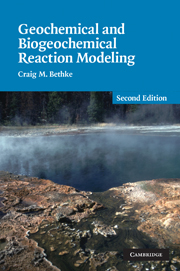Book contents
- Frontmatter
- Contents
- Preface
- Preface to first edition
- A note about software
- 1 Introduction
- 2 Modeling overview
- Part I Equilibrium in natural waters
- 3 The equilibrium state
- 4 Solving for the equilibrium state
- 5 Changing the basis
- 6 Equilibrium models of natural waters
- 7 Redox disequilibrium
- 8 Activity coefficients
- 9 Sorption and ion exchange
- 10 Surface complexation
- 11 Automatic reaction balancing
- 12 Uniqueness
- Part II Reaction processes
- Part III Applied reaction modeling
- Appendix 1 Sources of modeling software
- Appendix 2 Evaluating the HMW activity model
- Appendix 3 Minerals in the LLNL database
- Appendix 4 Nonlinear rate laws
- References
- Index
10 - Surface complexation
Published online by Cambridge University Press: 05 August 2012
- Frontmatter
- Contents
- Preface
- Preface to first edition
- A note about software
- 1 Introduction
- 2 Modeling overview
- Part I Equilibrium in natural waters
- 3 The equilibrium state
- 4 Solving for the equilibrium state
- 5 Changing the basis
- 6 Equilibrium models of natural waters
- 7 Redox disequilibrium
- 8 Activity coefficients
- 9 Sorption and ion exchange
- 10 Surface complexation
- 11 Automatic reaction balancing
- 12 Uniqueness
- Part II Reaction processes
- Part III Applied reaction modeling
- Appendix 1 Sources of modeling software
- Appendix 2 Evaluating the HMW activity model
- Appendix 3 Minerals in the LLNL database
- Appendix 4 Nonlinear rate laws
- References
- Index
Summary
Sorption of species from solution, as we noted in the previous chapter (Chapter 9), controls the mobility of certain species in solution, especially environmental contaminants. An accurate description of sorption, therefore, is a critical component of many geochemical models. The sorption models presented in the previous chapter are, however, too simplistic to be incorporated into a geochemical model intended for use under general conditions, such as across a range in pH.
The distribution coefficient (Kd) approach and Freundlich and Langmuir isotherms are applied widely in groundwater studies (Domenico and Schwartz, 1998) and have been used with considerable success to describe sorption of uncharged, weakly sorbing organic molecules (Adamson, 1976). Ion exchange theory can account well for sorption of major cationic species on the clay fraction of a soil or sediment (Sposito, 1989; Stumm and Morgan, 1996). None of these models, however, accounts for the electrical state of the surface, which varies sharply with pH, ionic strength, and solution composition. The Kd and Freundlich approaches prescribe no concept of mass balance, so that a surface might be predicted to sorb from solution without limit. Each approach requires that coefficients be determined experimentally for a given combination of sediment and fluid, and hence lack generality.
To be useful in modeling electrolyte sorption, a theory needs to describe hydrolysis and the mineral surface, account for electrical charge there, and provide for mass balance on the sorbing sites. In addition, an internally consistent and sufficiently broad database of sorption reactions should accompany the theory. Of the approaches available, a class known as surface complexation models (e.g., Adamson, 1976; Stumm, 1992) reflect such an ideal most closely.
- Type
- Chapter
- Information
- Geochemical and Biogeochemical Reaction Modeling , pp. 155 - 168Publisher: Cambridge University PressPrint publication year: 2007



